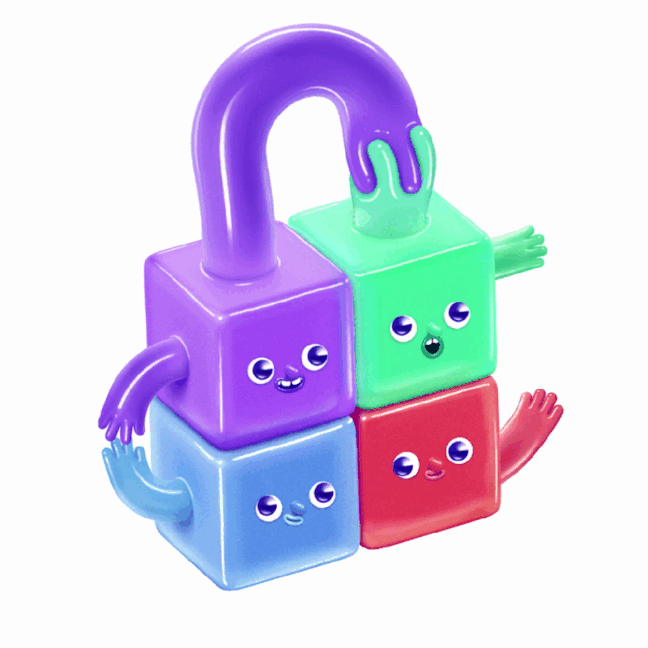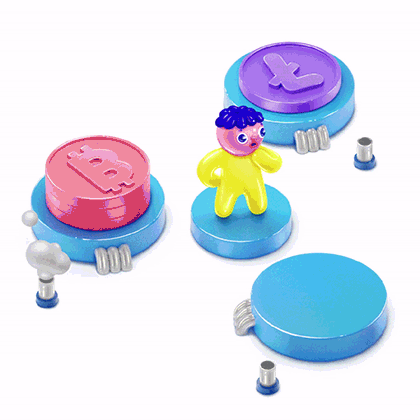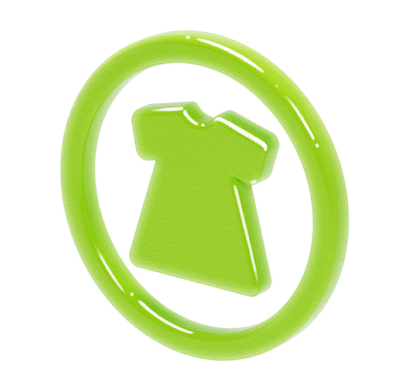WE’LL BREAK IT DOWN FOR YOU
by Jonathan Vatner and Alex Joseph
Animations by Carlos Miranda ’23
Ready for a trip? Strap on a virtual reality headset and jump into the metaverse. There you can catch a Beyoncé concert from the front row, parachute past the Eiffel Tower, or chat up distant friends you haven’t seen in years. Trade some Bitcoin for an NFT of a Gucci gown, slide it on your avatar, and head to the bar for a (virtual) drink while taking in a TED talk by your favorite TikTok influencer. And don’t worry: No one can steal your identity or cash because blockchain is keeping all transactions secure.
This is the promise, at any rate, of a host of technological innovations known as Web3—including the metaverse, blockchain, cryptocurrencies, and NFTs—that futurists say are about to radically change our lives. In recent months, as the crypto markets have imploded, many detractors have voiced serious skepticism about Web3 innovations. Still, some experts maintain that Web3 holds the potential to transform a range of business and creative enterprises that are extremely relevant to the FIT community. William Reinisch, chair of the Entrepreneurship Department and an investor in Web3 technologies, says, “It will fundamentally shift the creative industries.”
Confused? Worried? You’re not alone. Prize-winning economists, journalists, and educators are struggling to articulate the meaning and implications of Web3. But if you’re turning to Google to learn more, you already have a small sense of one big problem these technologies are trying to solve. “A lot of Web3 is looking at how we can move away from the behemoths that control so much of our lives and make these things more seamless and fair for individuals,” says Franklin Boyd, an attorney who has helped her art-world clients navigate this technology for over a decade. Boyd teaches a course about Web3 for FIT’s Center for Continuing and Professional Studies.
So whether you’re an early adopter or a petrified Luddite, get ready to surf the internet in a whole new way—in a virtual body, on a virtual surfboard NFT, purchased on the Ethereum blockchain. We can’t promise this sea of change won’t leave you seasick, but we do promise to lay it out as clearly as we can. Proceed with caution, though; at press time, much of this information remained in flux.
THE METAVERSE(S)
An immersive, synchronous internet

People talk about “the metaverse” as if it’s one gigantic, immersive world, but there are actually many, many metaverses that look wildly different. “I don’t see it as a single metaverse but as a multiverse of microverses,” says Michael Ferraro, executive director of FIT’s DTech Lab, an innovation space that connects students and faculty with industry. “These microverses will be branded entertainment experiences, bubbles in a cluster of environments.”
One of these metaverses is called The Sandbox. It’s a two-dimensional sandbox game, meaning there’s no goal to win anything. Instead, like children build sandcastles in an actual sandbox, gamers construct virtual island environments, which can be bought and sold with cryptocurrency.
You don’t need a headset to enter, just a computer or your phone. Once you’re in, you can go to a concert by a hot DJ—the Warner Music Group has space there. The TV show The Walking Dead owns an island where you can play a game that, as the online publication VentureBeat reported, “encourages players to unite with friends and other players as they overcome the day-to-day requirements of surviving a zombie-infested habitat: scavenging for food, gathering resources, … making alliances, and more.” Built on the Ethereum blockchain, The Sandbox has plenty to buy—from outfits to artworks—and if you purchase a plot of land, you can host a game, throw a party, build an art gallery, or anything else you want to do.
In December, the Council of Fashion Designers of America mounted its first-ever metaverse fashion exhibition in The Sandbox. FIT alum Darnell-Jamal Lisby curated the show, which featured digital versions of outfits by Fashion Design alumni Stephen Burrows ’66, Norma Kamali ’65, and Calvin Klein ’63. (Lisby, assistant curator of fashion at the Cleveland Museum of Art, earned three degrees at FIT: Fashion and Textile Studies: History, Theory, Museum Practice MA ’18, Art History and Museum Professions ’16, and Fashion Merchandising Management ’14.) Lisby created the narrative and chose the garments. Sandbox technicians digitally rendered the styles and simulated museum galleries.

A virtual world that promises infinite freedom: That’s one kind of metaverse. Online gamers have been building and exploring these environments for years in Second Life (founded in 2003) and in the games Fortnite and Roblox, among others. But games are just the beginning. Double A Labs is a custom metaverse platform for businesses, a choose-your-own-adventure landscape of information to explore, conversations and collaborators to engage with—all designed to improve relations with your employees, connect with clients, and build an audience for your brand. “Everybody keeps saying the metaverse is going to happen in five years,” says Double A Labs CEO and founder Amber Allen, an FIT Foundation board member. “We’re there now. Our platform is ready.”
There’s even a metaverse of sorts right on FIT’s campus, constructed by the DTech Lab. Download an app called Membit and stroll down 27th Street, and you can see, through your phone, digital avatars of faculty and staff members who have devoted their careers to protecting the environment. DTech used a sophisticated scanner with 36 cameras to create the holograms in augmented reality and turn the street into something like a sustainability-themed version of the Pokemon GO mobile game.
So “the metaverse” is actually a hypothetical synthesis of all metaverses: A visitor to The Sandbox should be able to seamlessly enter Fortnite without having to log out, log in, or switch browsers. In 2021, Facebook staked a claim to this putative space by changing its name to Meta. But while Meta may yet construct an all-encompassing virtual environment (their first version, Horizon Worlds, launched a year ago), the very idea of Facebook at the center of the metaverse goes against the principles of Web3. Web2 was defined by social media—users uploaded content that would be owned by the tech giants. But Web3 is about decentralization—users own their stuff. “No one’s going to own the metaverse,” says Dan Shefelman, chair of Illustration and Interactive Media, “though they’ll try.”
Better Tech for a Better Metaverse
Web3 aims to take immersive online experiences to the next level. That may mean more lifelike virtual environments and VR headsets. Or not. The Sandbox is visually arresting but not particularly realistic. Allen says in testing the technology for Double A Labs, she found that executives wouldn’t wear headsets for more than a few minutes. “I honestly thought the platform would be more 3D, but the adoption rate [of VR headsets] wasn’t there,” Allen says. Avatars in Double A Labs appear not as animated characters but as the users’ headshots, which provide “a human connection.”

Improving the metaverse presents a far greater challenge than just developing better wearables. Generating enough computing power to allow hundreds of millions of avatars to interact in real time also presents a significant hurdle. The full realization of the metaverse’s potential is a way off, says Corey Moran, Cosmetics and Fragrance Marketing and Management MPS ’15, head of industry, fashion and luxury at Google. “There are a lot of buzzwords and very little application—yet—that is meaningful and has proven sticky,” he says.
BLOCKCHAIN
The lockbox that makes Web3 possible
Though the grand vision for Web3 remains elusive, technology that lays the foundation for this monumental shift is already in use. Blockchain, first employed in 2008 as the basis for the cryptocurrency Bitcoin, is a decentralized way to record transactions—the perfect tool, in other words, to underpin the decentralized metaverse. In the future, our avatars will pass instantly from one environment to another, using a blockchain-supported digital “wallet.”

“We know what a pain it is to log on to so many websites and remember your passwords,” says Renee Leibler, a longtime Web3 investor and educator who co-teaches two courses on the topic with Assistant Professor William Reinisch. “That’s where information gets hacked—it’s a really big problem that Web3 is going after.”
The security of blockchain has other applications, too. Seatz, a startup working on preventing counterfeit tickets for concerts and other events, is the recent invention of Leyla Arcasoy, Fashion Business Management ’24, and Sarah Marina Thompson, International Trade and Marketing ’24. One 2018 poll found that 12% of online ticket purchases turned out to be a scam. “I’ve had friends lose hundreds of dollars on inauthentic tickets,” Thompson says. “They can appear valid and be stored on your Apple Wallet, but when you get to the venue, you realize they’re fake.”
Blockchains store the entire history of transactions for an asset—in this case, tickets. Tickets purchased on Seatz will be linked to a digital version of the purchaser’s driver’s license or passport and stored in a blockchain, so that only the ticket buyer can attend the event; the ticket cannot be duplicated and can be resold only through the Seatz platform. The technology could also prevent bots from buying tickets, which is one reason Ticketmaster crashed when sales opened for Taylor Swift’s tour in November 2022.
Blockchain technology could also iron out one of fashion’s stickiest challenges: supply chain management. The process of creating a garment from raw materials is extremely complex, usually taking place in multiple countries. Brands often don’t know where their fibers were grown or even which factory is sewing their clothes—a major problem, since some countries tolerate child labor, forced labor, unsafe conditions, and environmentally harmful practices.
Lauren Breuer and Joshua Choi, both Production Management majors in Leibler’s and Reinisch’s classes, are attempting to track clothing and jewelry along the supply chain using blockchain. Choi, who works in production for a small jewelry company, logs details about each step—such as where the precious metals came from and which artisan crafted the piece—in a blockchain, thereby creating an unchangeable public record. If they are successful, the consumer will be able to scan a QR code and learn everything about what went into the product. “Throughout every step of the process, if there’s an authenticity issue, a quality issue, or a data issue, it would show,” Choi says.

CRYPTOCURRENCY
It’s money and much more


Cryptocurrency had a terrible 2022. FTX, the third largest crypto trading site, went bankrupt in November 2022 due to gross mismanagement of funds. Beanstalk, a crypto investment platform, failed in April 2022 when a hacker exploited a flaw in its setup to drain almost $200 million from users. Over the year, Bitcoin and Ethereum lost almost two-thirds of their value. Some question whether they will ever recover.
Regardless of whether crypto can become a trustworthy investment, experts say it is essential to the workings of Web3. Want to create an NFT of your artwork or sell it? You need a small amount of crypto.
Crypto is also accepted for many purchases in the metaverse … but usually you can use traditional currency, too. Advocates promise that crypto will one day facilitate speedier purchases with no credit card company or tech giant charging exorbitant fees.
A major criticism of cryptocurrencies is their high carbon footprint. Mining Bitcoin—which requires warehouses full of computers to be running day and night, competing to solve progressively more complicated math problems—is incredibly energy-intensive. According to Digiconomist.net, which tracks Bitcoin energy consumption, it consumed as much energy as Austria in January 2023.
Ethereum used to require comparable amounts of electricity, but in September 2022, in an event forebodingly named The Merge, it became much more energy efficient. Now the computers no longer compete, and as a result, artists looking to mint NFTs of their artwork on Ethereum don’t have to worry as much about exacerbating climate change.
NFTs
The future of asset authentication

In 2021, Collins Dictionary named “NFT” word of the year (beating out “crypto” and “metaverse”), and ArtReview magazine awarded it the top spot in its ranking of the most powerful entities in the art world. That March, an NFT artwork by famed digital artist Beeple sold for $69 million at a Christie’s auction—the most expensive NFT acquisition to date.
But what is an NFT?
Because digital artworks like Beeple’s JPG can be copied endlessly, they have traditionally been challenging to sell. That’s where the NFT, or non-fungible token, comes in. An NFT is a digital asset, logged permanently in a blockchain or digital ledger, that provides proof of ownership of something—a digital artwork or collectible, a physical artwork, a club membership, a tweet, or even a house. The image file can still be copied, but the NFT establishes ownership. It’s an electronic certificate of authenticity.
CryptoPunks, a collection of 10,000 illustrations of faces minted in 2017, are some of the first NFTs—and among the most valuable. They were originally given away for free; in February 2022, one resold for $23.7 million. The Bored Ape Yacht Club is a collection of ape illustrations, minted by a group of creative technologists in April 2021. Celebrities like Paris Hilton and Justin Bieber bought them, helping to drive prices up, and a few months later, a Bored Ape resold for $3.4 million. For a while, all the cool kids wanted NFTs.
Major artists—Damien Hirst, Takashi Murakami, Frank Stella—have also created NFT collections. And museums have minted and sold NFT editions of their masterworks as a fundraising tool. According to The New York Times, a series of NFTs created from Klimt’s The Kiss netted the Belvedere Museum in Vienna 4.3 million euros. So far, it does not seem to have affected the price of the physical artwork.
Purchasers of NFTs may be rewarded with perks. Bored Ape owners have access to chats and live events with the community of other owners. Owners of the LFC Heroes Club, an NFT collection created by the Liverpool Football Club and sold through Sotheby’s, can meet players and get discounts on merchandise.
Nathan Yu, Fashion Business Management ’18, created limited editions of NFT trading cards featuring K-pop stars, with a tiered system of perks. Yu is chief strategy officer of KStarLive, a South Korea-based media company producing K-pop news for a global audience.
The NFTs featured short videos of K-pop stars from a KStarLive music TV series called The Show. The digital cards were sold as mystery boxes for about $20 each in crypto, so fans didn’t know which star they would get. Also, the cards were classified according to rarity and came with perks that scaled from “common” to “legendary.” Fans who won one of 40 “epic” cards could attend The Show tapings for life; one “legendary” winner also got a free trip to Seoul, South Korea.
Yu used NFTs for a few reasons. First, in the K-pop world, there are a lot of scalped tickets and unlicensed merchandise, so bringing authenticity to the trading cards cut down on fraud. Second, many K-pop fans live in places without sophisticated banking systems, so cryptocurrency could make international purchases easier.
Next, KStarLive will roll out profile picture NFTs—images of K-pop icons that fans can use on their social media profiles. Having a valuable profile picture “is a new way of flexing with this generation,” Yu says.
NFTs vs. the Art World
NFTs raise a host of ethical and legal questions for art dealers and scholars. The ability of artists to sell directly to buyers online has caused consternation among gallerists, worried that “it could make the art world obsolete,” according to Natasha Degen, chair of the MA program in Art Market Studies. Galleries serve an important purpose, she explains: They assign artwork value and keep prices steady, and without them, the value of artworks could skyrocket or plunge based on the whims of the market.
“On the one hand, NFTs offer the possibility of forging your own path as an artist,” Degen says. “But there are reasons why gatekeepers exist and why the gallery system doesn’t just show work but also offers exhibitions where artwork can be contextualized in history.”
Additionally, galleries offer consumer protections not available in the Wild West of the internet, says Paul Melton, associate professor of Art Market Studies. And most of the traditional galleries also curate NFTs. Without the help of a gallery, naive buyers could lose staggering sums—on a digital artwork that drops precipitously in value, for example.
Legally, NFTs raise even more issues. Degen points out that bad actors can mint and sell NFTs out of artworks that are not their own. It’d be like making a copy of a Van Gogh and selling it as if it were real. If you buy a plagiarized NFT, you’ve wasted your money. Even in the seemingly ephemeral world of digital art, provenance matters.
Melton notes that NFTs raise questions for museums, too. “How is a digital artwork cared for, both in terms of conservation and questions of deaccessioning?”
Despite these concerns, artists are still exploring the medium. C.J. Yeh, professor of Communication Design Pathways, minted his first NFT in February 2022. Without gallery representation for his NFTs, it has been a challenge to develop an audience, but he is excited by the technology. “I see this being an interesting channel for artists, designers, and brands,” he says.
Carlos Miranda ’23, who created the art for this story, was intrigued by NFTs as a way to sell his predominantly digital art. “I’m always thinking about how I can sell my work if it’s not something physically painted,” Miranda says. “It’s hard for a digital artist like me. People don’t see that work made on a computer has much value.”
Miranda was selected to list his NFTs on SuperRare, an NFT marketplace that resembles a gallery in that it presents curated collections to buyers. The site even hosted a physical pop-up in a Soho gallery in 2022, with the artworks displayed on monitors. So far, he has sold just one.
The Future of NFTs

In 2022, NFT sales slowed considerably, and many questioned whether there was a future in digital art. A Bored Ape that Justin Bieber bought in January 2022 for $1.3 million was worth only $69,000 by November. Remember those Klimt NFTs? At press time, they were listed on OpenSea for as low as 0.56 ether (about $870), less than half of the original price. And an NFT of Jack Dorsey’s first tweet, which sold for $2.9 million in 2021, was pulled from auction in 2022 after the top bid came in at a paltry $280.
“The market got overheated, and there was a lot of excitement,” Degen explains. “There’s definitely been a correction, and we probably won’t see prices go quite as high as they have been.”
Still, Degen sees a future in this method of digital authenticity. “We live in a digital world, and digital art is going to be important going forward,” she says. “All major businesses in the art world have incorporated blockchain, cryptocurrency, and/or NFTs.”
Renee Leibler, who teaches Web3 technologies in the Entrepreneurship Department, doesn’t know if people will be minting and buying NFTs in the future, but she believes the underlying concept remains important. “Whether or not you think NFTs are going to be a bubble, you cannot discount the fact that you now have digital authenticity, which can relate to art, domain names, scientific papers, or music. We’ve never had that before.”

DIGITAL FASHION
The power of virtual clothes

What will we wear in the metaverse? That’s a $6.61 billion question—the amount the market for digital fashion is expected to grow by 2026, according to a November 2022 report by market-research firm Technavio. Those who make the metaverse a part of their lives—and a 2022 report by Citi predicts 5 billion users by 2030—will want to express their personality through fashion via their avatar. Fashion designers and brands are working to ensure consumers have plenty of options.
Nike, Gucci, and Balenciaga have spaces in the multiplayer online video games Fortnite and Roblox, where players can interact with digital fashions and even buy them. Luxury brands like Balenciaga and Prada staged virtual runway shows to present both digital versions of real garments and fantastical digital-only creations.
Some of these garments are sold as NFTs, which allows owners to wear them in multiple games and metaverses; others are less expensive copies, wearable only in the game where they’re purchased. In 2021, a digital Gucci bag on Roblox sold for $4,115, more than the retail price of the physical bag. And that wasn’t even an NFT.
Diesel launched its NFT brand D:Verse in February 2022, offering digital versions of four of the season’s runway fashions. The effort was spearheaded by Stefano Rosso, International Trade and Marketing for the Fashion Industries ’03, who is CEO of BVX, the new Web3 arm of Diesel’s parent company, OTB group. In his previous role as CEO of Diesel North America, Rosso fell in love with gaming culture and recognized its growing importance. “I realized that gaming was going to change everything, from the entertainment system to the way we interact online,” he says.


Creating the first D:Verse collection was a learning experience. Rosso’s initial target audience—the traditional Diesel consumer—wasn’t interested, so he switched to Web3 natives, people who are already spending money—sometimes large sums—in the metaverse.
Rosso emphasizes the importance of making NFT ownership a continued benefit.
“When you drop an NFT, you should not think the game is over—that’s where the game starts. The community is investing in you, and they expect opportunities to come from it.” D:Verse NFTs come with perks galore. Buyers get access to a private chat room for connecting with other fans, and to discounted NFT pre-sales, raffles, and additional digital wearables. Other benefits have included invitations to a Diesel fashion show in Milan and an event at the flagship in New York City, more digital wearables for their avatars and Snapchat filters, physical versions of the NFT fashions, and the ability to vote on the colors of a limited-edition sneaker.
Yet metaverse fashion is still in its infancy, says Jamie Pallot, an executive producer for Sensorium, a VR platform that creates large-scale immersive media experiences. He says brands that successfully market digital fashion are rare. “For every two or three examples of a creatively inspired, well-managed, and seamlessly handled project, there are tens if not hundreds of washout attempts where some brand says, ‘Hey, we made 100 NFTs of blah blah,’ and nobody buys them.”

Virtual Fashion Shows
Most brands are still figuring out how—and whether—to present fashion shows in the metaverse. FIT’s DTech Lab is experimenting in this space. Since its founding in 2017, the innovation lab has helped apparel companies embrace digital fashion design. Recently, a partnership with Cotton Incorporated pioneered virtual fashion shows that tell a story. A team of students and faculty created narrative videos that put digital versions of student-designed cotton garments into 3D environments to demonstrate high-tech finishes and inspire designers to use them. The three dramatic videos show avatars in a snowscape, in a desert, and on a sailboat.
“It was the first foray into using 3D virtual prototyping to create a new vision of the fashion exhibition that’s narrative but is situated in a metaverse,” says Michael Ferraro, executive director of the DTech Lab.
Democratizing Design
Digital design isn’t just for major brands; it’s creating new career possibilities for those who want to launch collections without a huge cash inflow.
By day, Kevin Tung, Fashion Design ’16, works as an associate designer at White House Black Market; by night, he is building a career in digital fashion. His aha moment came in 2020, when a virtual pair of sneakers sold for $15,000. Those “Cybersneakers” were created by RTFKT (pronounced “artifact”), a digital fashion company that Nike acquired in 2021. RTFKT’s sneaker NFTs can now be worn in select metaverses and video games.
Tung joined a designer network called Digitalax and participated in Digital Fashion Week New York, which offers virtual runway shows, discussions, and a metaverse trade show. Many digital fashions are pure fantasy—they defy gravity or look like they’re on fire, but Tung’s body-conscious pieces, accented with metallics, could be translated into fabric.
He believes digital fashion will be the breeding ground for future designers. “Every designer wants their own label, but you need a lot of money and time,” he says. “Digital fashion levels the playing field. In 10 years, I think you’re going to see a lot of creative directors getting their start in digital fashion.”
Metaverse Skeptics
To many, interacting in the metaverse sounds exciting, a peak experience and a demonstration of the wonders of technology. To others, it sounds depressing. “I am in no way sold on the metaverse,” says curator Danielle Paterson, Art Market Studies MA ’22, Photography and the Digital Image ’20. “I don’t want to go to a party from my couch.”
But the metaverse era does seem to be happening, whether we like it or not. Double A Labs founder Amber Allen compares it with the adoption of the internet. “In ’94, Katie Couric was like, I don’t want this internet. And now it’s everything. If I told you 20 years ago that we’re going to find our lovers, our community, our shopping online, would you have believed me? I promise this new shift will be the same.”
Read about how FIT faculty members are exploring the world of digital design in these related stories: Displaying Digital Art in the Metaverse, Digital Design in the Apparel Industry, and Exploring Phygital Fashion.













